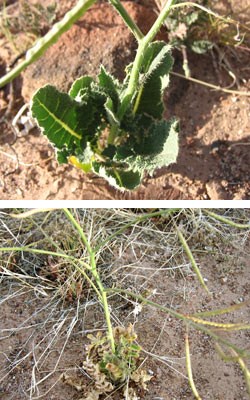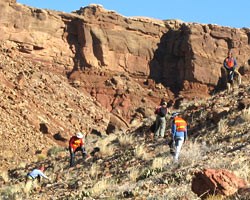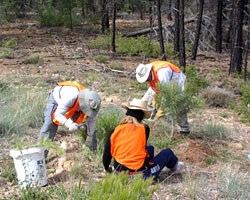
NPS PHOTOS BY ALLYSON MATHIS In February and March 2008, volunteers assisted Grand Canyon National Park’s Science and Resource Management staff in removing the aggressive invasive plant commonly known as Sahara mustard (Brassica tournefortii) at Lees Ferry. Sahara mustard, a new arrival to the area, poses a serious ecological threat to the Grand Canyon ecosystem. In the past few years, Sahara mustard has become one of the most dominant plants found near the mouth of the Paria River and it now literally surrounds the campground at Lees Ferry. Sahara mustard is native to north Africa, southern Europe, and the Middle East. It is adapted to arid climates and sandy soils. Although it was first recorded in California in the 1920s, it has spread in the last few years throughout the low elevations of the deserts in California and Arizona, and east to New Mexico and Texas. Sahara mustard now forms a dense blanket in some portions of Glen Canyon National Recreation Area, and is threatening the survival of rare dune plants at Lake Mead National Recreation Area. Some ecologists in California worry that entire ecosystems may be at risk because of Sahara mustard; other scientists have warned that native vegetation in entire national parks could be destroyed in decades. Sahara mustard can take many shapes and forms, growing from only five inches tall to more than four feet. It often has large basal leaves that can smother surrounding plants and rob the early spring moisture from winter annuals. As a fast growing weed, it can outcompete native plants. It is also allelopathic, meaning that it inhibits the growth of other plant species. Pulling plants, particularly along roadways and in other human use areas like campgrounds, before they produce mature seeds is the best way to control Sahara mustard. In the last several years, volunteers have made important contributions to this effort at Lees Ferry. In 2007, volunteers removed 35,000 Sahara mustard plants. In 2008, Grand Canyon’s vegetation crew led three trips to Lees Ferry, in which a total of 37 volunteers pulled almost 90,000 Sahara mustard seedlings and surveyed 300 acres in Grand Canyon National Park and Glen Canyon National Recreation Area.
NPS PHOTO Molly Boyter, the Grand Canyon National Park Invasive Plants Biologist who led the 2008 trips said, “The volunteers at Lees Ferry this spring worked diligently and enthusiastically. Even though the plants were very small this year, all of the volunteers happily combed the hillsides and removed all of the tiny plants that, if left untouched, could set seed and become a huge problem next year. It was satisfying to work with members of the Grand Canyon community as well as interested people from across the US and South Korea on such an important project. I am anticipating that with all the volunteers' hard work next year's germination of Sahara mustard will be greatly diminished and our native habitats will remain protected.” Volunteers play an important part of preserving Grand Canyon’s natural and cultural resources, and are critical in the park’s effort to preserve the natural vegetation communities of Grand Canyon. In addition to assisting in the control of invasive plant species like Sahara mustard, volunteers collect native seeds, salvage native plants prior to construction activities, replant disturbed areas, inventory rare and exotic plants, and help maintain the park’s native plant nursery. Grand Canyon’s Division of Science and Resource Management vegetation crew offers volunteer trips throughout the year. The trips are fun, educational, and allow people who love Grand Canyon the opportunity to make a direct contribution to the preservation of park resources. Participants in volunteer trips camp in group campsites, and are provided all meals and snacks during multi-day trips, and lunches and snacks during shorter trips. The park also provides all tools and safety equipment including work gloves. In addition to their volunteer contributions, participants have the opportunity to meet other people, learn about the park’s Science and Resource Management program, and enjoy the beauty of Grand Canyon National Park. 
NPS PHOTO Volunteer trips upcoming in 2008 include seed collection and invasive plant removal on the North and South Rims, and assisting with plant propagation and maintenance at the South Rim’s Native Plant Nursery. Trips will continue to be offered in 2009, including more opportunities for volunteers to help control Sahara mustard at Lees Ferry in early spring. See http://www.gcvolunteers.org for a listing of all future volunteer trips with Science and Resource Management’s vegetation program. |
Last updated: February 24, 2015
